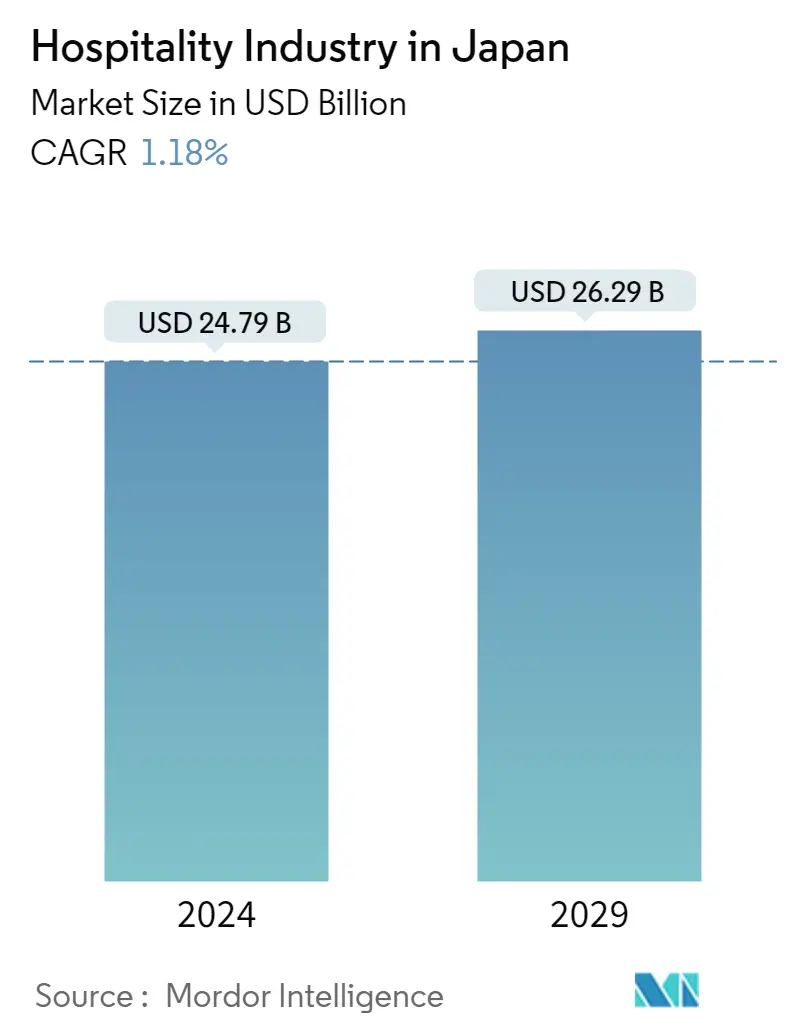Market Size of Hospitality Industry in Japan

| Study Period | 2020 - 2029 |
| Base Year For Estimation | 2023 |
| Market Size (2024) | USD 24.79 Billion |
| Market Size (2029) | USD 26.29 Billion |
| CAGR (2024 - 2029) | 1.18 % |
| Market Concentration | Medium |
Major Players
*Disclaimer: Major Players sorted in no particular order |
Japan Hospitality Market Analysis
The Hospitality Industry in Japan Market size is estimated at USD 24.79 billion in 2024, and is expected to reach USD 26.29 billion by 2029, growing at a CAGR of 1.18% during the forecast period (2024-2029).
In Japan, hotel performance remained weak for most of 2021. However, slightly recovering occupancy rates from the previous half-year are almost at the levels seen in 2H/2020, even without the help of the 'Go To' Travel campaign. Moreover, hotel revenues have also improved slightly. In 2H/2021, the average daily rates (ADR) index increased by 0.8 points half-year-on-half-year (HoH), and the revenue per available room (RevPAR) index increased accordingly by 3.8 points HoH.
With the COVID-19 pandemic drastically decreasing revenue from accommodation and other key revenue streams, such as corporate events and banqueting, the hospitality industry in Japan has been struggling over the past two years. 2020 saw a rapid increase in the number of bankruptcies, exceeding 120 cases, more than half of which resulted from the pandemic. While the number of bankruptcies in 2021 has fallen, more than two-thirds were due to the pandemic, showing its lingering effects.
Budget hotels, in particular, have been hit harder by the pandemic due to the large supply in the market. The small room sizes of such hotels appear to be an issue for both customers and operators, especially after the pandemic.
Overseas investors have also been looking at the Japanese hospitality industry. For instance, Baring Private Equity Asia acquired The B Osaka Midosuji, a large hotel in Chuo ward, Osaka, in a transaction estimated at over JPY 10 billion (USD 74 million). Overall, while 2021 has seen large transactions in the hotel sector, transaction volumes have been relatively low considering the pandemic.
Japan Hospitality Industry Segmentation
The hospitality industry is a broad category of fields within the service industry, including lodging, food, drink service, event planning, theme parks, travel, and tourism. It includes hotels, tourism agencies, restaurants, and bars. The Hospitality Industry in Japan is Segmented by Type (Chain Hotels and Independent Hotels) and by Segment (Service Apartments, Budget and Economy Hotels, Mid and Upper Mid-scale Hotels, and Luxury Hotels). The report offers market size and forecasts in value (USD billion) for all the above segments.
| By Type | |
| Chain Hotels | |
| Independent Hotels |
| By Segment | |
| Service Apartments | |
| Budget and Economy Hotels | |
| Mid and Upper Mid-scale Hotels | |
| Luxury Hotels |
Hospitality Industry in Japan Size Summary
The hospitality industry in Japan is gradually recovering from the significant impacts of the COVID-19 pandemic, which had severely affected revenue streams such as accommodation, corporate events, and banqueting. The sector experienced a notable increase in bankruptcies during the pandemic, particularly among budget hotels, which faced challenges due to market oversupply and small room sizes. Despite these challenges, there has been a resurgence in hotel performance, with improved occupancy rates and revenue metrics. The return of international travelers, facilitated by eased border restrictions and a favorable exchange rate, has contributed to this recovery. The luxury hotel segment is witnessing increased interest from international brands, as Japan offers a relatively untapped market compared to other countries, with a limited number of luxury accommodations.
The Japanese hospitality market is predominantly dominated by domestic brands, which hold a significant share of the market. Companies like Toyoko Inn Co., Route-Inn Hotels, and APA Hotels & Resorts are key players in this space. However, technological advancements and service innovations are enabling both domestic and international companies to expand their presence. Recent developments include the opening of new hotels by international brands such as Hyatt and YOTEL, which are introducing unique offerings and technologies. These trends indicate a dynamic market landscape, with opportunities for growth and expansion in the coming years.
Hospitality Industry in Japan Market Size - Table of Contents
-
1. MARKET INSIGHTS AND DYNAMICS
-
1.1 Market Overview
-
1.2 Market Dynamics
-
1.2.1 Drivers
-
1.2.2 Restraints
-
1.2.3 Opportunities
-
-
1.3 Porter's Five Forces Analysis
-
1.4 Insights into Revenue Flows from Accommodation and Food and Beverage Sectors
-
1.5 Leading Cities in Japan with Respect to Number of Visitors
-
1.6 Investments (Real Estate, FDI, and Others) in the Hospitality Industry
-
1.7 Technological Innovations in the Hospitality Industry
-
1.8 Insights into Impact of Shared Living Spaces on the Hospitality Industry
-
1.9 Insights into Other Economic Contributors to the Hospitality Industry
-
1.10 Impact of COVID-19 on the Hospitality Industry
-
-
2. MARKET SEGMENTATION
-
2.1 By Type
-
2.1.1 Chain Hotels
-
2.1.2 Independent Hotels
-
-
2.2 By Segment
-
2.2.1 Service Apartments
-
2.2.2 Budget and Economy Hotels
-
2.2.3 Mid and Upper Mid-scale Hotels
-
2.2.4 Luxury Hotels
-
-
Hospitality Industry in Japan Market Size FAQs
How big is the Japan Hospitality Market?
The Japan Hospitality Market size is expected to reach USD 24.79 billion in 2024 and grow at a CAGR of 1.18% to reach USD 26.29 billion by 2029.
What is the current Japan Hospitality Market size?
In 2024, the Japan Hospitality Market size is expected to reach USD 24.79 billion.

